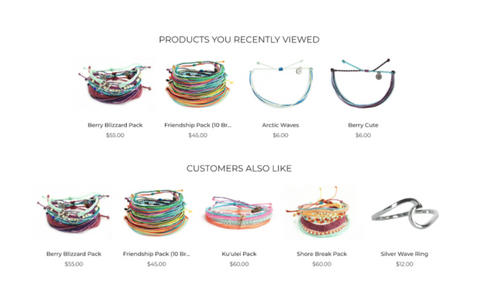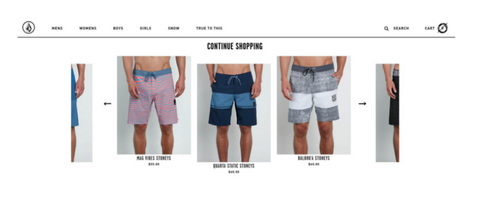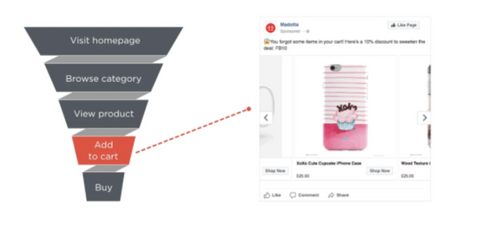Customer experience plays a pivotal role in building brand engagement, boosting retention and driving revenue, but all too often merchants fail to capture customers' attention from the get-go. Why? Because of poor ecommerce personalisation.
The most successful brands are the ones that keep their customers happy by giving them what they want; a personalised experience. Gone are the days of a one-size-fits-all approach. Customers expect, or even demand, a shopping experience that suits their needs and makes them feel like a valued customer. So, it’s your job to give them exactly that.
In this article, we discuss what ecommerce personalisation is and how you can achieve it to boost your business’s conversion rate...
What is ecommerce personalisation?
Ecommerce personalisation is a marketing tactic that merchants use to tailor a customer’s shopping experience based on the user’s needs or interaction history. This includes product recommendations, email marketing or targeted promotions.
The level of personalisation depends on the kind of information you collect about the customer. For example, the customer’s location, browser history, purchase history or level of brand engagement.
Simply put, ecommerce personalisation is the practice of delivering the right message to the right customer at the right time. So, for your ecommerce personalisation strategy to be successful, it must add value to the customer.
Here’s how to determine your personalisation strategy’s value…
Value*=[Relevance + Timeliness / Loss of privacy] Trust
*Value to the customer
What are the benefits of personalisation?
When you implement ecommerce personalisation, there’s a whole host of benefits including…
- Increased brand loyalty and advocacy
- Boosted brand engagement
- Stronger customer relationships
- Reduced acquisition costs
- Higher customer lifetime value (CLV)
- Great ROI
- More conversions
Sounds good right? Keep reading to find examples of how other merchants are using ecommerce personalisation to grow their businesses.
20 Ecommerce Personalisation Examples
Now you know the basics of personalisation and its benefits, let’s explore how other merchants use ecommerce personalisation to grow their businesses.
#1 Seasonal Content
Seasonality significantly impacts how we shop, particularly when it comes to fashion. Customers look for different products depending on the time of year.
You can get prepared early and pre-empt this interest by implementing on-site banners in your homepage navigation or include notification and offers that are tied to the changing seasons. Highlight summer and winter clothing ranges, as well as holiday promotions like Halloween, Christmas and Black Friday.
But be mindful that seasonal content will not apply to every segment of your market. For example, the UK is currently in the middle of winter, but in Australia it’s summer. So, you must account for seasonal variations in different countries and hemispheres.

Why not go one step further and implement weather-targeted product recommendations. This is a great way to influence buying decisions based on real-time weather and is a surefire way to gaining a competitive advantage over our competitors.

#2 Geo-Location Alerts
If you have separate international stores it might be a good idea to implement geo-location alerts when your customer lands on your site. This way a customer is redirected to the right site (currency) if they land on the wrong one.
#3 Personalise Your Homepage
Think of your homepage as your shop window. It’s your customer’s first impression of your store and it’s a prime space for advertising products, promotions and offers.
Whenever a customer lands on your homepage, they should see a host of personalised links to their preferred categories, suggested items, recently-viewed products, and more. So, leverage what you know about a customer and use this to tailor their shopping journey in an easy-to-use way.
#4 Personalising Product Recommendations
One of the most popular and effective ecommerce personalisation examples is personalised product suggestions. For each product, there are other products users have bought and viewed. Related items are a great up-selling and cross-selling tactic.
What’s more, adding ‘recently viewed’ products to your customer’s journey is often the extra push they need to make that all-important purchase. This is because most buyers browse before buying, so when they’re ready to buy they can easily come back to your store and find the product they were looking for.
Also, we’d recommend promoting bestsellers and trending items on your homepage. This creates a sense of urgency and increases your conversion rate.
Product recommendation carousels are versatile and can be added to almost anywhere on your website. From experience, we find the most commonly seen include:
- Homepage: Bestsellers, Recommended for you, Trending right now, Recently viewed
- Product page: Related items, Similar items, Recently viewed
- Collection page: Bestsellers, Recommended for you
- Checkout page: Recommended for you

#5 Show Continuous Shopping For Returning Customers
Many high-growth ecommerce businesses use the ‘Continue shopping’ tactic, allowing customers to pick up where they left off in just a click. This approach remembers your customer’s selected items and preferences through previous sessions, making it easier for them to buy in the future.

#6 Personalised Search Results
As an ecommerce business, there’s a lot of things you can do to make your customer’s shopping journey smoother.
For example, you can utilise what you know about returning customers and show the most relevant information when they search. Offering category suggestions allows your customer to keep their search broad, whilst focusing on their interests.
Similarly, you can tailor the search results page by displaying personalised recommendations based on browsing history. And if you add cross-selling and upselling promotions to the mix things can really get exciting!
#7 Personal Emails
A surefire way to take your business to the next level is through email marketing. It’s cheap and effective. However, with so many emails cluttering your customers’ inboxes these days, you’re going to have to create emails that are jam-packed with personalised content, killer CTA’s and high-quality imagery to stand out.
Also, you must segment your customers based on shopping behaviour including most visited pages, wishlists etc. And include product recommendations and imagery in your emails.

#8 Message Customers On Important Days
As we mentioned above, personal emails are a great way to boost conversions. So, why not go further and message your customers on special days, including birthdays and anniversaries. These kinds of emails and personalised offers make the customer feel special and prompt purchase, as well as building loyalty and engagement.

#9 Re-engage With Past Subscribers
One of the best ways to re-engage dormant customers is to send personalised emails that spark their attention. This includes something as simple as a ‘we miss you’ email to remind the customer they haven’t shopped with you in a while. Or a juicy discount code to entice them back to your store.

# 10 Abandoned Cart Emails
An excellent way to win back lost sales is through automated abandoned cart emails. Often it’s the case that the customer has got distracted during their shopping journey, so a friendly, personalised reminder can be the helpful prompt they need.
#11 Let Your Customers Personalise Their Products
Another great personalisation tactic is giving your customers the flexibility to personalise their products. Whether it’s a colour change or adding gift-wrap, these small touches can make a huge difference. So, if it’s possible to offer personalisation options, do it.
#12 Freedom To Set Marketing Preferences
Allow your customers to pre-select general marketing preferences when signing up. Doing this will give customers control over the kind of marketing content they receive, which means they’re more likely to convert because the promotions and updates will be specific to their interests.
#13 Use Live Chat
Just because your customers are choosing to shop online doesn’t mean human interaction is no longer important. In fact, customers crave a deeper connection with brands, particularly during a global pandemic.
Rather than leaving your customers to search for the answers themselves, offer an instant live chat feature which will save them time and make them feel valued. Live chats are conversational and offer the customer a more human touch which boosts loyalty and improves customer experience.
#14 Use Chatbots
In recent years, chatbots have become increasingly popular, enabling merchants to interact with their customers 24/7 - great for scaling businesses with customers in various time zones.
Some people argue that chatbots lack a personal touch, but this isn’t a problem when you use AI-driven chatbots because they recreate the experience of talking to a real person and can even offer personalised product suggestions.
#15 Let Customers Save Their Favourite Items (“Wish List”)
It’s inevitable that whilst browsing visitors will come across products they like but aren’t ready to buy.
When you implement a ‘Wish List’ function to your store it allows customers to save items for a later date - increasing chances of purchase.
You could also incorporate ‘Wish Lists’ into your email marketing efforts. For example, if a product in a customer’s wish list is low in stock or discounted, inform the customer via email. This will create a sense of urgency and increase the chances of a sale.
#16 Show Your Customers Name When They’re Logged Into Their Account
This is a simple example of personalisation, but you’d be surprised how many sores don’t do this.
When a customer is logged into their account, show their name in the header. It’s a quick and easy way to reassure customers that they can purchase without having to input all their information or login again. And they’ll also know that they can access their account features in just a few clicks.
#17 Multiple Shipping Options
It’s important to offer customers a variety of shipping options. This is because some customers are willing to pay extra for speedy shipping, whilst others aren’t in a hurry and would rather save. The more options, the better!
And don’t forget to be transparent about your shipping costs from the very beginning. No customer wants the surprise of paying more than they bargained for at check-out. So, display your delivery options on product pages with clear CTA’s.
# 18 Personalised Retargeting Ads
Once a customer has visited your store, you’ll have a better understanding of what products they’re interested in. You can use this behavioural insight to retarget them and create a personalised shopping experience.
There are lots of options when it comes to types of content you can use when retargeting. For example, you can show customers their recently viewed items or suggested items based on their browsing history. And you can also remind customers of products they abandoned in their cart.
This is where tools like Facebook pixel come in handy (despite what you may have heard about the latest iOS14 update).

#19 Personalised Post-purchase Experience
A customer’s shopping experience doesn’t end at check-out, so why should personalisation? This is where a post-checkout page comes in. It’s the perfect opportunity to engage your customer further on a deeper, more personal level.
There are a few ways merchants can do this, including a referral incentive, a CTA to sign up to a newsletter or a discount code for the customer’s next purchase.
#20 Personalise Your Pop-ups
Personalisation can significantly improve the effectiveness of your pop-ups, not to mention enhance the customer experience.
Several tools on the market can help you create personalised pop-ups based on your customer’s interests. You can also customise when in the customer journey you would like the pop-up to appear. The key is to make your pop-up as unobtrusive as possible.
However, it’s worth noting that some customers find pop-ups annoying, especially when they appear frequently. So, always follow best practices when it comes to pop-ups and avoid distracting your customer from the end goal; the purchase!
Conclusion
As you can see, offering your customers a personalised experience doesn’t mean you have to redesign your whole ecommerce store. But it’s something that should be taken into consideration if you want to boost conversions. And don't forget that it’s vital to take an omnichannel approach. Personalisation isn’t just about your website. You need to include other channels including email, SMS, customer service and social media.
Here at Velstar, we take a data-driven approach to personalisation. We leverage the very best technology to create highly personalised, targeted content that customers love. If you’d like us to help you, get in touch today!




